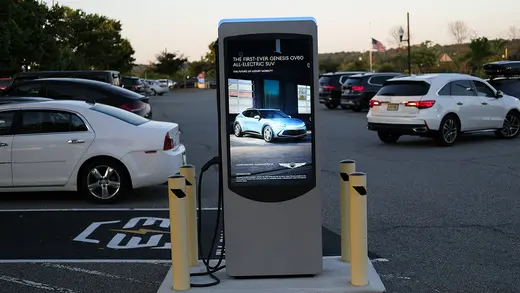What the Historic U.S. Climate Bill Gets Right and Gets Wrong
The Inflation Reduction Act promises the largest investment in climate action in U.S. history—$370 billion—and could lead to significant emissions reductions over the next decade.
By experts and staff
- Updated
Experts
![]() By Alice C. HillDavid M. Rubenstein Senior Fellow for Energy and the Environment
By Alice C. HillDavid M. Rubenstein Senior Fellow for Energy and the Environment
By
- Madeline BabinResearch Associate, Climate Change Policy
What major climate action is included in the Inflation Reduction Act (IRA)?
The Inflation Reduction Act of 2022 [PDF], approved by Congress and signed by President Joe Biden in August, is set to deliver the largest investment in climate action in U.S. history. Congress has directed nearly $370 billion over the next decade to rapidly scale up renewable energy production and drive substantial reductions in greenhouse gas emissions.
The historic legislation invests in a variety of efforts, including low-carbon technologies, environmental justice initiatives for disadvantaged communities, and tax credits to promote electric vehicle sales. The IRA pours $27 billion into creating a green bank to finance clean energy technologies and emission-cutting infrastructure, such as residential rooftop solar panels. Billions more go to climate-smart agricultural practices and clean-vehicle manufacturing facilities. Additional funding for consumer programs—including those that underwrite the use of heat pumps, which are energy-saving systems that help regulate home temperatures—will improve home energy efficiency. The IRA also directs $1.5 billion to reduce methane leaks from natural gas production to support the U.S. commitment to the Global Methane Pledge.
On the resilience side, Congress will hand out $5 billion in grants to support fire-resilient forests, forest conservation, and urban tree planting. The bill also allocates several billion dollars in funding for drought resilience in western states.
What doesn’t it include?
The bill focuses heavily on emission-cutting solutions to climate change and mostly neglects resilience.
In its aim to make buildings more energy efficient, it misses an opportunity to make sure buildings will withstand the climate-fueled extremes that the nation is already experiencing and will continue to endure. Last year, climate events inflicted more than $152 billion in damages across the country, and this year, climate change has brought flash flooding in California, Kentucky, and Montana as well as wildfires in Alaska, California, and New Mexico. The National Oceanic and Atmospheric Administration (NOAA) predicts increased hurricane activity in the coming months. When communities rebuild after disasters, they risk restoring structures doomed to fail in the next catastrophe, since the United States lacks climate-resilient building codes.
What are other concerns about the bill?
Some measures included in the IRA could inadvertently harm U.S. climate efforts. For example, the bill includes a clean hydrogen tax credit, which is intended to help drive down the cost of hydrogen production. However, recent findings* have cast doubt on hydrogen’s role in a clean energy future. Scientists have found that hydrogen, which is prone to leaking, contributes to global heating when it escapes into the atmosphere. Using hydrogen to tackle climate change will require effective monitoring of leaks, but current technology only detects amounts high enough to cause explosions.
The legislation also includes a provision that tethers offshore wind leasing to oil and gas extraction. Over a ten-year period, the Interior Department will be prohibited from issuing a lease for offshore wind development unless at least sixty million acres—the size of Michigan—have been leased for oil and gas in the previous year. The bill also requires that the Interior Department offer to lease** at least two million acres of public lands—more than double the size of Rhode Island—for oil and gas drilling as a prerequisite for any renewable energy development on public lands. Experts, such as the Center for Biological Diversity’s Brett Hartl, have voiced concern that “handcuffing” renewable energy development to new oil and gas extraction will “fan the flames of climate disasters torching our country.”
Will the legislation lead to meaningful reductions of greenhouse gas emissions?
Analysts predict that the IRA will result in a 41 percent reduction [PDF] in U.S. emissions by 2030, compared to 2005 levels. While this would be an improvement from the projected 27 percent reduction that would have happened regardless of the bill’s passage, it falls short of the Biden administration’s commitment to reduce emissions by at least 50 percent from 2005 levels by 2030.

However, additional federal regulatory action or increased state and local climate efforts could make up the difference. And the bill’s provisions that lower clean energy costs and incentivize investment in renewables will alleviate some of the barriers that have deterred state and local action, which could galvanize the efforts needed to bridge the gap.
Will it improve the United States’ global image?
The IRA will go a long way toward restoring the United States’ credibility as a global leader on climate. As the largest emitter historically and the second-largest emitter currently, the United States faces skepticism as it urges other nations to act on climate. By effectively demonstrating a plan to fulfill climate commitments, the IRA will strengthen U.S. legitimacy in international climate negotiations when nations convene in November for the twenty-seventh Conference of the Parties (COP27).
While setbacks to the administration’s climate agenda have “slowed the pace” of other countries’ emissions-reduction efforts, as U.S. climate envoy John Kerry has said, the United States’ passage of the biggest climate legislation in its history could inspire other countries to take action to avoid falling behind.
Are there any challenges to rolling out the legislation?
Because the IRA has a decade-long timespan, the risk remains that changes in administration could slow climate investment. Still, since this is a congressional act—not an executive order—it will require legislative or judicial action to undo, thus making it harder to reverse. In addition, courts will likely be less sympathetic to any claims that federal rulemaking pursuant to the bill violates the major questions doctrine recently articulated by the Supreme Court in West Virginia v. Environmental Protection Agency (EPA).
Ensuring that the IRA’s funding goes to initiatives that actually help combat climate change will pose a challenge. For example, though the bill allocates billions of dollars to support climate-smart agriculture, critics have warned that some of the targeted programs could do more harm than good by funding projects that increase emissions by incentivizing land clearing, fertilizer use, and intensive animal breeding.
*Editor’s note: Author Alice C. Hill is on the board of the Environmental Defense Fund, which produced this report.
**Editor’s note: The legislation only requires that land be offered for leasing, not that it actually be leased.
